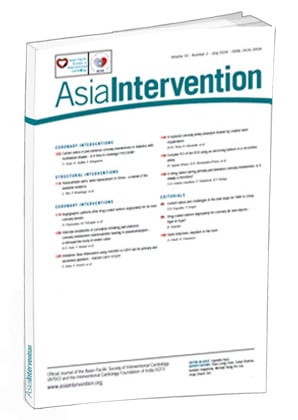Dear friends,
It was nice meeting many of you who could participate in EuroPCR 2024 this May in the friendly environs of Paris. The meeting this year was bigger and, like previous years, very educational. Everyone got what they were looking for in the fields of coronary and structural interventions, “the pearls of wisdom”; the common goal being how to improve the outcomes of our patients.
The Editorial Board is pleased to bring you this second issue of 2024. As you already know, this year we will have three issues. The third issue will be released later this year, coinciding with the AICT-AsiaPCR congress to be held in Singapore on 4-5 October.
This issue begins with a topical review article by myself and my colleagues on the current status of percutaneous coronary intervention (PCI) in diabetic patients with multivessel coronary disease. Every third patient with ischaemic heart disease needing revascularisation has diabetes. Although patient preference is invariably for a non-surgical intervention, we are always bogged down by the results of the FREEDOM study of 2015 conferring a survival advantage to coronary artery bypass grafting. Nearly a decade has passed, with significant all-round improvements in PCI and medical treatment of diabetes. This prompted us to include a reappraisal on the subject. Sripal Bangalore from New York University and Sudhir Krishna from the stent industry joined me in writing this. This article also introduces the ongoing TUXEDO-2 India, a study comparing the outcomes of current-generation drug-eluting stents (DES) coupled with present-day optimal medical treatment with the FREEDOM trial.
Another review article in this issue is on transcatheter aortic valve replacement (TAVR) in China, where this non-surgical technique is increasingly being used as a replacement for the well-established surgical method. This Chinese experience from Lai Wei, Yan Wang et al describes their experience with Chinese-made valves, especially the self-expanding Venus A-Valve and the well-known non-domestic balloon-expandable SAPIEN valve. Their results show acceptable all-cause 30-day and 1-year mortality rates, in spite of half of the patients having bicuspid valves. The need for multiple valves was significant, and the permanent pacemaker implantation rate was low. In the accompanying editorial on this experience, Samir Kapadia and Toshiaki Isogai, emphasise the need for cautious enthusiasm and suggest having a mandatory national registry for TAVI. Another shortcoming pointed out is in not having comparative studies of the locally made valves with the internationally well-known valves like the Medtronic Evolut and the Edwards Lifesciences SAPIEN valve. They have cited the example from India with their domestic Myval valve, which has comparative studies.
Drug-coated balloons (DCBs) have an established and accepted place in the management of in-stent restenosis; however, their role in treating de novo coronary lesions is increasingly being demonstrated. In this issue, Naohiro Funayama, Makoto Furugen et al propose a follow-up angiographic classification after a successful DCB angioplasty. According to the study, more than 90% of cases had no restenosis pattern, with 46% showing a lumen enlargement. The restenosis group had focal restenosis followed by diffuse restenosis and a very small group, of 1% of patients, showing a complete occlusion. These excellent results are commented upon in an editorial by Bruno Scheller. He describes it as proof of progress, moving away from rigid tubes to a therapy which restores the obstructed artery with natural vascular function. This, however, needs large randomised studies and real-world data before adopting it as an alternative or replacement for the current treatment with DES.
Next in line is an article regarding a rare complication after coronary stenting presenting in the form of pseudoaneurysms as a result of infection leading to stent abscesses. In this retrospective study of 11 cases from several Indian centres, Rajesh Gopalan Nair, Vidhu Anand et al describe the clinical features and risk factors of this serious complication, which has no clear treatment guidelines. Identifying them in time could lead to development of standardised approaches. In their editorial comment, Anil Dhall and Kirti Punamiya mention that it is an often-ignored problem and emphasise the need for a national registry. They also advise the operators to have a high index of clinical suspicion in patients developing fever and/or pericarditis in the postprocedural period. The need for a Heart Team approach with a microbiologist to manage this serious problem is also suggested.
Radiation dose attenuation to protect the primary and secondary operators is an important area of concern in cath labs. Sandeepan Saha, Satyendra Tewari et al describe the use of a radiation protection drape “RADPAD” along with the standard methods and compare it with no use of RADPAD during prolonged procedures in the RADAR-CATH STUDY. They show significantly reduced exposure with the use of this special drape.
The issue has also three interesting flashlights on coronary interventions. Mao Matsuyama Terui, Ryoichi Miyazaki et al report on a ruptured coronary artery aneurysm successfully treated by a covered coronary stent implantation. Heberto Aquino Bruno, Kevin R. Hernandez-Flores et al describe a complex PCI of the right coronary artery using an anchoring balloon in the adjacent anomalously arising circumflex artery, and G. Dimpu Edwin Jonathan, Somalaran Venkatesh and Vivek Baliga describe an interesting image of a filling defect which was an aneurysm masquerading as a thrombus.
We hope you enjoy reading this issue and that you also share these articles with your peers, colleagues and students. It would also be appreciated if your research studies and flashlights are sent regularly for publication in AsiaIntervention, which is the official journal of the APSIC and INDIALIVE. On our end, we will do our best to provide a quick response and a turnaround time as short as possible.
